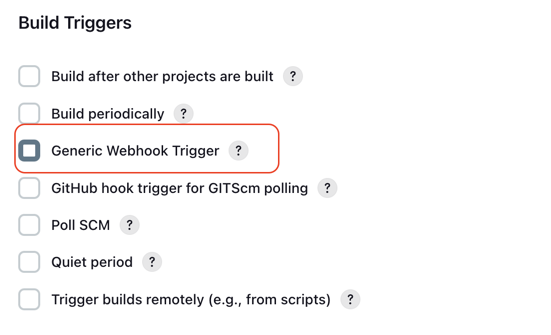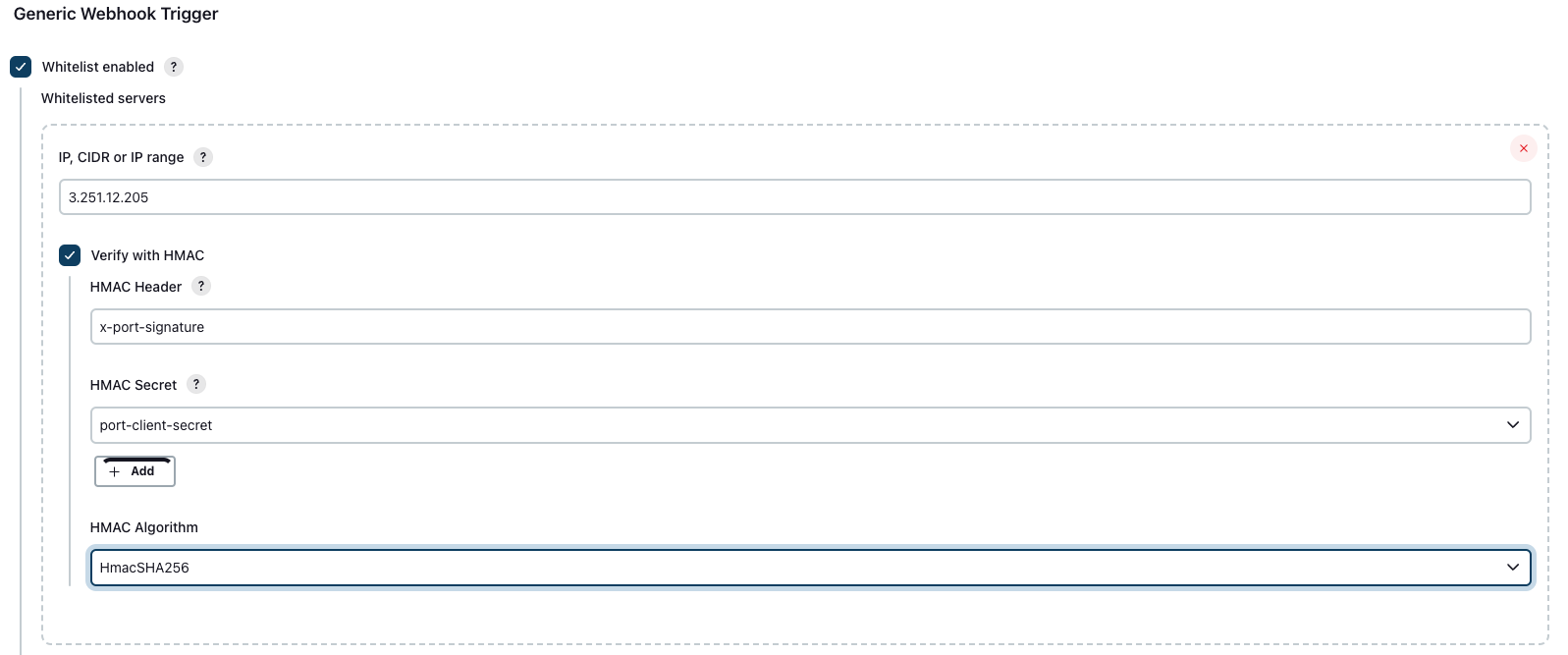使用 webhooks 触发 Jenkins
在本指南中,您将学习如何使用Webhook Actions 从 Port 触发您的Jenkins Pipelines。

上图所示步骤如下:
- 在 Port 中调用一个操作;
- Port 使用 SHA-1 对操作有效载荷进行签名,签名值为
clientSecret,并将其放入X-Port-Signature请求头中。 信息 使用请求标头验证 webhook 请求有以下好处: - 确保请求有效载荷未被篡改- 确保信息发送方是 Port
- 确保收到的信息不是旧信息的重放
:::
3.Port 通过向
https://{JENKINS_URL}/generic-webhook-trigger/invoke发送POST请求来发布调用的WEBHOOK消息 示例流程如下: 1.开发人员要求运行 Jenkins 管道; 2.Port 向 Jenkins webhookURL发送带有动作有效载荷的POST请求; 3.Jenkins webhook 接收新的操作请求; 4.Jenkins webhook 触发 Pipelines;
先决条件
Jenkins 所需插件
- Generic webhook trigger - 允许使用 webhook 调用触发 Jenkins Pipelines。
设置 webhook
为 Pipelines 启用 webhook 触发器
要启用使用 webhook 引用触发 Jenkins 管道,需要在管道中添加 "通用 Webhook 触发器 "作为构建触发器。
在任务页面中,进入 "配置"选项卡,向下滚动到 "构建触发器"部分。 选中 "通用 Webhook 触发器 "复�选框:

默认情况下,为作业启用 webhook 触发器时,可通过向 http://JENKINS_URL/generic-webhook-trigger/invoke 发送事件来触发作业。这意味着,如果未另行配置,向该路由发送事件时将触发所有作业。建议设置job token ,以避免运行不需要的作业。
定义变量
选中复选框后,请查看 ** Pipelines 内容参数** 部分。 在这里您将定义传递给 Pipelines 运行的变量。
- Varues "字段的值应与作业配置中定义的、作业运行所期望的变量名称相匹配。
- 表达式 "字段应设置为 "JSONPath",并指向 Port 操作发送的相关属性。
[
{
"identifier": "runPipeline",
"title": "Run Pipeline",
"icon": "Jenkins",
"userInputs": {
"properties": {
"input1": {
"type": "string"
}
}
}
... # Port Action configuration
]
以下是触发操作并发送到 Jenkins 时生成的有效载荷示例:
{
... # Event metadata
"payload": {
"properties": {
"input1": "input1_value"
}
}
}
例如,"输入 1 "的 JSONPath 应为
$.payload.properties.input1
Port操作 - 完整的Port操作定义可在here 上找到。
令牌设置
token parameter 允许触发特定(或一组) 作业。
要为任务设置令牌,请向下滚动到令牌部分,然后提供任务令牌:

保存后,您就可以通过以下 URL 具体触发该工作任务:
http://JENKINS_URL/generic-webhook-trigger/invoke?token=<JOB_TOKEN>
设置 Port 操作
要触发 Jenkins 管道,您需要设置一个 PortWebhook Action 。
下面是一个触发 webhook 的操作示例:
[
{
"identifier": "runPipeline",
"title": "Run Pipeline",
"icon": "Jenkins",
"userInputs": {
"properties": {
"input1": {
"type": "string"
}
}
},
"invocationMethod": {
"type": "WEBHOOK",
"url": "http://JENKINS_URL/generic-webhook-trigger/invoke?token=<JOB_TOKEN>"
},
"trigger": "CREATE",
"description": "Run Jenkins pipeline"
}
]
确保 webhook 的安全
可以通过configuring whitelisting 为暴露在外的 Pipelines 添加保护层。
白名单为您提供了以下安全选项:
- 限制可发送触发 Pipelines 请求的 IP 地址列表;
- 为 webhook 有效负载内容添加validation ,以验证其是否真正来自 Port。
下面是所需配置的示例:

- IP 字段应设置为 "3.251.12.205",这是我��们托管的外呼 WEBHOOK Gateway;
- 有关 Port 外呼的更多信息,请查看 Port 的actions security 页面。
- 在 HMAC Secret 字段中,选择一个包含您的
port-client-secret的 secret。
如果该secret还不存在,请使用this guide 创建一个 "secret文本 "类型的secret。该secret的值应该是您的 "Port 客户端secret",可根据指南here 找到。
向 Port 报告 Jenkins 操作运行状态
成功触发 Jenkins 管道后,必须在 Port 中更新运行操作的状态。
为了更新操作,需要创建 RUN_ID 变量,并将其设置为从action payload 获取:

下面的代码片段演示了如何向 Port 报告 Pipelines 的进度:
Click here to see the code
import groovy.json.JsonSlurper
pipeline {
agent any
environment {
PORT_CLIENT_ID="YOUR_CLIENT_ID"
PORT_CLIENT_SECRET="YOUR_CLIENT_SECRET"
ACCESS_TOKEN = ""
}
stages {
stage('Get access token') {
steps {
script {
// Execute the curl command and capture the output
def result = sh(returnStdout: true, script: """
accessTokenPayload=\$(curl -X POST \
-H "Content-Type: application/json" \
-d '{"clientId": "${PORT_CLIENT_ID}", "clientSecret": "${PORT_CLIENT_SECRET}"}' \
-s "https://api.getport.io/v1/auth/access_token")
echo \$accessTokenPayload
""")
// Parse the JSON response using JsonSlurper
def jsonSlurper = new JsonSlurper()
def payloadJson = jsonSlurper.parseText(result.trim())
// Access the desired data from the payload
ACCESS_TOKEN = payloadJson.accessToken
}
}
}
stage('Send logs example') {
steps {
script {
def logs_report_response = sh(script: """
curl -X POST \
-H "Content-Type: application/json" \
-H "Authorization: Bearer ${ACCESS_TOKEN}" \
-d '{"message": "this is a log test message example"}' \
"https://api.getport.io/v1/actions/runs/$RUN_ID/logs"
""", returnStdout: true)
println(logs_report_response)
}
}
}
stage('Update status example') {
steps {
script {
def status_report_response = sh(script: """
curl -X PATCH \
-H "Content-Type: application/json" \
-H "Authorization: Bearer ${ACCESS_TOKEN}" \
-d '{"status":"SUCCESS", "message": {"run_status": "Jenkins CI/CD Run completed successfully!"}}' \
"https://api.getport.io/v1/actions/runs/${RUN_ID}"
""", returnStdout: true)
println(status_report_response)
}
}
}
}
}